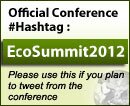« Go back to e-newsletter overview
EcoSummit 2012 E-Newsletter: August 2012
Food Security to Be Addressed at EcoSummit 2012
"...civilization itself rests upon the soil." ~President Thomas Jefferson
Professor Rattan Lal takes a positive approach to what appears to be a staggering problem. He recently wrote that the world is faced with what he calls “the trilemma of climate change, food security and energy demand.” Despite these challenges he said, “It can be addressed.”
The answer, he said, is in the soil.
“We have the land, air and water to address these issues so long as they are managed in a sustainable way,” Lal said.
Lal is the distinguished university professor of soil science and director of the Carbon Management Sequestration Center at The Ohio State University, College of Food, Agricultural, and Environmental Sciences, and is a former president of the Soil Science Society of America. He is one of the featured plenary speakers at EcoSummit 2012.
Humankind places great demand on the soil, and those demands will be exacerbated in the coming years. Food production, already at a tipping point for the estimated 1 billion people who are food-insecure, will become more challenging as the need for food nearly doubles by 2050.
And the challenges of climate change on the food supply could be dramatic. According to Lal, it is estimated that if the mean global temperature increases by 2 degrees Celsius, the result may be a 25 percent reduction in agricultural output.
These demands on the soil are compounded as we look for biofuel alternatives to our current sources of fossil fuels. The corn stalks and the tall grasses that are being removed from the fields to be turned into energy not only reduce the amount of vegetation dedicated to human consumption, but also take away valuable nutrients that would nourish future crop growth.
Another reason for working green manure, such as tall grasses, back into the soil is that the cattle dung or plant stock that is burned for fuel generates soot and releases carbon into the atmosphere. Plants and manure are both very useful to conserving soil and water and more productive if left in the field.
Many of the problems and answers came into sharper focus for Lal when he visited a farm in Mexico a few years ago and met a farmer who sold crop residues to be used as feed or fuel. Lal asked the farmer why he didn’t spread the residues in the fields where its nutrients and micronutrients would replenish the soil to benefit the next year’s crops.
“The farmer said, ‘You are thinking of next year. I am thinking of my family needs for tomorrow morning,’” said Lal.
Lal said the farmer’s comment is descriptive of the problems that arise when one person owns the land and somebody else farms it.
“There needs to be equity. Most of the small landholders in sub-Saharan Africa are women, but they don’t own the title of the land. If the landowner and the farmer were the same person, they might take a longer view of their land,” Lal said.
We must manage land that is suitable for cultivation in an environmentally friendly manner. We have the knowledge. We know what to do. And the solution is better management of land and water and resources. We can solve the problem provided there is the will to solve it,” Lal said.
See other articles in the August 2012 newsletter:
- Sustainability at the Forefront of Green Events Guide and Green Ribbon Program
- Register Now for MORPC's 2012 Summit on Sustainability & the Environment
- A Celebration of Silent Spring
- EcoSummit 2012 International Film Festival: Call for Submissions





